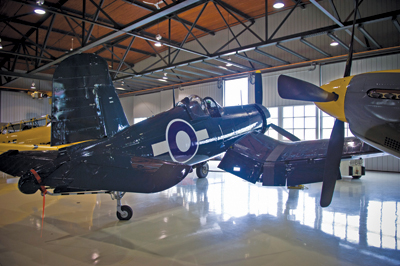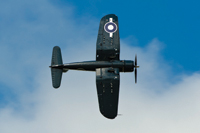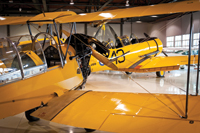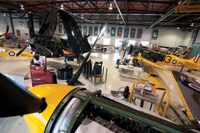
Features
Operations
On the wings of a dream
For some, old aircraft provide an opportunity to remember times past. For others, they represent a chance to experience history that is still alive and real. And for many, the sound of an old piston engine, or sight of the aircraft flying, is a fitting memorial to people and events that hold significant importance.
July 8, 2011 By Rob Seaman
For some, old aircraft provide an opportunity to remember times past. For others, they represent a chance to experience history that is still alive and real. And for many, the sound of an old piston engine, or sight of the aircraft flying, is a fitting memorial to people and events that hold significant importance.
No disrespect to modern aircraft, but older “birds” create an emotion, memory and thrill that their current generation counterparts have not yet earned. And as more than one vintage aircraft pilot or engineer has said – “we do not own them, we are just looking after them until they pass to someone else who will care for and appreciate them as we do.” Those who operate a vintage aircraft are “custodians” for the present, keeping something for the future in good order.
I have always found vintage aircraft owners to be interesting and willing to share tales relating to their pride and joy. Driving around to explore airports when I was still in university led me one day to discover a group at the Mount Hope Airport near Hamilton. It was the Canadian Warplane Heritage (CWH) – in its infancy. At that time, the collection was based in one of the old hangars left over from the Commonwealth Training Command days. There were six Harvards of various models and ages, a B25 Mitchell, a TBM Avenger, a FG1D Corsair, and a Chipmunk that made up the flyable portion of the collection. To enter this magical place, you walked in through an open hangar door from the ramp – there was no real security in those days.
 |
| A VWoC Corsair, a Harvard (left) and a P51 Mustang (right) grace the modern hangar of Vintage Wings Canada. The hangar was created in the image of a period facility. Advertisement
|
In the side rooms were a couple of projects underway that would one day result in the Yale and Lysander that are now part of the museum’s active fleet. The hangar also sheltered a temperamental Tiger Moth that was not airworthy but getting slow and steady attention from some other volunteer folks. The same could be said for the Avro Anson.
This was the nucleus of what was to become the first and, at present, largest museum of flyable aircraft in this country. It was started by a handful of like-minded businessmen who wanted to fly something more interesting than the Cessna and Piper aircraft they had at the time. They began with a Fairey Firefly in rented space at Pearson airport in Toronto and then moved to Mount Hope. The operation grew from there – flyers, engineers, and others like myself came on board – folks who wanted to learn and be involved. Through donations, events and various funding activities, what started as a little club grew to become the business and respected museum we see today. For Canada, it was groundbreaking work that others have come to benefit from in many ways. CWH was on the leading edge of the operation and maintenance of older aircraft, including relations with Transport Canada for PPCs and airworthiness issues.
 |
|
| The VWoC Robert Hampton Grey Memorial FG1D Corsair in flight. This is the second aircraft to wear these colours in the history of the Canadian aviation museums. |
This series of firsts did not come without its setbacks. Tragedies along the way included a hangar fire that took a number of aircraft but luckily spared the Avro Lancaster bomber. Before that, there was the loss of the original Firefly and CWH co-founder Alan Ness in an air show mishap. Then there was the emergency landing that led to a fire and loss of the first P51 Mustang (although happily there were no fatalities in this case). In later years, the Corsair was sold to sustain the museum financially (and also save the cost that would be involved in some required and extensive repairs).
Some of the early members who brought their wisdom, experience and enthusiasm to help build the spirit as well as physical attributes of the CWH have passed over the years. They were in their retirement (or close to it) when the museum started, and for many, the ability to learn from their real experience is something that fortunately has been passed along. A young fellow could learn a lot by sitting and listening back then – which many of us did. CWH today is no longer alone and while it led the way, it now has some very good “company” in the flying museum arena.
A growing interest
One of the most recent and quickly rising members of the flying museum fraternity is Gatineau, Que.-based Vintage Wings of Canada (VWoC). Michael Potter, following his retirement from a highly successful career in the technology sector, started this museum. Potter’s interest in collecting vintage aircraft started in 2000. As his acquisitions grew, he decided to form a foundation to acquire, manage, maintain and fly the aircraft. He has also recruited a core group of professional pilots from the ranks of former military personnel and the National Research Council Flight Test Laboratory, to assist in managing, displaying and flying the collection. The 18 aircraft (all but two of which are currently flyable) are displayed by these pilots at events both home based and within reasonable travel from the home base.
Recently, there has been some “correction” to the VWoC collection – in part to make room for the new acquisitions and also as a result of the organizaiton’s refocus from vintage aircraft to more notable Canadian military ones. Accordingly, some of the earlier parts of the group have been or currently are for sale. The remaining aircraft in the group are each presented in the “colours” of a noted Canadian aviation veteran or discipline.
As of May 2011, VWoC completed and returned to the air its Fleet “Cornell” – making a total “training” fleet of four aircraft representing the Commonwealth Training Command Program of WWII. Restoration work continues on the second of three Spitfires – the Roseland Supermarine Spitfire Mk IX. Also in the spring of 2011, VWoC brought home the remnants of the third – a Mk XIVe that will now enter a long-term restoration program.
One of the most noted aircraft in the collection is an F86 Sabre – or, more accurately, Canadair Sabre Mk 5 – that has become known across this country as Hawk One. A flyable aircraft when acquired, Hawk One was redone to celebrate the 100th anniversary of powered flight in Canada and repainted into the famous colours of the Golden Hawks aerobatic team (who operated from the late 1950s to 1964, when they were disbanded). Many target this as the golden age for the RCAF and the tribute is well received.
 |
|
| Training aircraft hold an important place in Canada’s aviation history. Here is a primary trainer Tiger Moth (foreground) and an advanced trainer Harvard (background).
|
Another Ontario group that operates vintage aircraft in similar, but more focused, efforts is the Canadian Harvard Association – a Tillsonburg, Ont., group whose volunteer museum includes six Harvard aircraft, a Tiger Moth and a Yale (which has been completely restored over the past 18 to 20 years and is currently waiting for its Certificate of Airworthiness from Transport Canada).
For those whose interests run a little more recent, there is also a relatively new group to check out – the Jet Aircraft Museum – a charitable aviation foundation specializing in Canadian Forces jet aircraft. The museum officially opened in September 2009 and is located at the London International Airport.
For those whose interest goes back to before the Second World War, you can’t miss the Great War Flying Museum located at the Brampton Flying Club. This unique collection has an interesting and unique assembly of replica First World War aircraft (many of which members built themselves). Visitors get up close and personal with the aircraft and learn from the dedicated members about a time when aerial warfare was is in its infancy and chivalry still played a very big role in things.
Buying vintage aircraft
If owning and operating your own vintage aircraft is a dream, it’s one that can be easily satisfied – for the right money, of course. Over the years, vintage aircraft have proven to be a good financial investment, as the demand and collectibility has increased.
I remember reading in a book called Flying the Old Ones by Paul Mantz (he made his fame and fortune putting together aircraft fleets for movies and TV shows in the 1960s and 1970s) how when assembling some Second World War fighters, he went to a desert “boneyard” and chose parts from a line of available Corsairs. What he noted was the fuel in the tanks was worth more than what he was paying for the entire aircraft! How things have changed.
In the early days of the CWH, a P51 could be had for under $100,000. Dennis Bradley, founder of the museum, advised me in 1980 that if I were smart, I would invest the $15,000 (or less) required for an L-Bird (vintage observation and utility aircraft from the Second World War) and enjoy the aircraft while watching its value grow. I wish I had listened; today the entry level for such an aircraft is at minimum $50,000 – and that buys something basic and worth restoring. As for the exotic or “big iron” warbirds like a P51, you had best be prepared to start at a cool $1 million.
Courtesy Aircraft, based in Rockford, Ill., has been a leader in the brokerage of war aircraft for many years. Founded in 1957 by D.M. Clark, as a new Cessna aircraft dealer, the firm grew through the ’60s to include Piper and Champion (Citabria) dealerships. In addition, Courtesy was active in the sales of select used aircraft. In the early ’70s, due to the knowledge and enthusiasm of the founder’s son, Mark Clark, Courtesy Aircraft became heavily involved in sales of a new market – warbirds. This market consisted primarily of Second World War and Korean era ex-military trainers, fighters and bombers, such as the T-6/SNJ Texans, P-51 Mustangs and B-25 Mitchells.
In the early ’80s, Clark purchased the company from his father and relocated to the Greater Rockford Airport in Rockford. The business continued to prosper and another new market began to emerge: the postmodern era warbirds such as the L Birds, T-34 Mentors, O-2 Fighting Skymasters and T-28 Trojans.
With more than 3,000 aircraft sold and delivered, Courtesy continues its tradition of excellence in the sales of both warbirds and civilian aircraft. According to Clark, there is no “typical” client. “There are guys who are on the Forbes 400 and guys in ‘hock’ who buy an L-bird. Some have one and others have 15 or more. Some fly all the time and others just have them parked under the G-550 wing. There are probably more guys that fly them than just polish them. Most of the owners like to share them with others so people can see them. And there are a lot of the ‘millionaire next door’ guys who have successful businesses and can afford to invest in the aircraft. I would say most of the buyers have GA aircraft in addition to a warbird.”
When looking at the current market, prices are stable or increasing, though the rate of increase has slowed. There’s also a trend among buyers to gravitate towards Second World War aircraft. “They seem to mean a lot for many different people,” he says. “They have touched many lives and almost everyone can relate to them. As the World War II guys die off, these aircraft are a link to their sacrifices and, as we know, the aircraft are not being made anymore.” As of May 2011, Courtesy had sold 17 aircraft. Last year, 56 were sold while 2009 marked the slowest year to date with 38, down four from 2008. The average price for a vintage aircraft was $300,000; however, the range has been from under $100,000 into the millions.
The recession has also caused lower unit sales but higher value per deal, Clark says. “The collector type aircraft seem to be going to larger collections and more aircraft per collector. Some of the smaller guys have been downsizing a bit. The fighters seem to always have the best appreciation, while the trainers are a good stable investment also, as the costs are lower and they are pretty liquid.”
 |
|
| Maintenance of vintage aircraft is an ongoing part of their responsible and safe operation.
|
Some of the hot items Courtesy has for sale include a North American F-86A Sabre – a very rare “A” model of the first swept wing jet fighter in the West. It boasts a complete and fully original cockpit and is the world’s only airworthy “A” model. It can be yours for a mere $1 million!
Another gem is a 1945 General Motors FM-2 Wildcat. This aircraft was delivered on Aug. 6, 1945, to NAS San Diego and then stricken from the Navy ranks on Nov. 30, 1945 – so it could be the lowest-time flown Wildcat still in existence. This is a current project that has been totally disassembled down to bare aluminum and brought back up with new hardware and equipment. It is possibly one of the most original Wildcats still flying with all original equipment, just as it would have rolled off the assembly line. It still retains its original armour plating, replica guns and radios. All hardware is CAD 1 plated “Silver” and it boasts original hose clamps, AN fittings and fabric-coated wiring. The aircraft still has a “Breeze” shotgun starter that uses a four-gauge blank shotgun cartridge to start the engine. Original shells and reloadable shells are included or a normal electric starter can be easily fitted. The price? A cool $1.295 million.
The point of purchase
When buying vintage or warbird aircraft there are important considerations to remember such as the aircraft’s damage history. In the GA world, previous damage history is a showstopper to a sale, but in this market, such things are virtually impossible to avoid and considered by many to be part of the provenance. Case in point, Courtesy has a second FM-2 “project” available for a mere $695,000. This aircraft is totally untouched so far and completely original.
The Wildcat is a great example of a pristine aircraft. Formerly assigned to a carrier training squadron in Lake Michigan in June of 1944, the Wildcat suffered a landing accident after only six months of service. After missing all of the wires on the USS Wolverine, it dropped off the bow, hitting the water and sinking to more than 250 feet. After spending 48 years under water, it was raised in 1993 and originally went to NAS Pensacola, where it spent a few years until it was traded out with a full release from the Navy.
Clark calls this one a “time capsule” as it still had the control lock in the storage compartment, Phenolic fuse pliers in the fuse panel and even paint chips on the gun blisters where spent shells would strike while being discharged. Back in the ’70s and early ’80s, most would pass on this aircraft as too much work and not worth the investment. Today, however, it is a rare find and worth the time and money required to return it to the skies.
More than just an investment
To some people, restoring vintage aircraft can be a lucrative pastime. I wish I had had the foresight, on more than one occasion, to tap into this market and to see its potential growth. But the fact is, it’s much more than that – owning a vintage aircraft helps connect the present to the past. It brings happiness and a sense of pride, harkening back to the golden age of aviation. And thanks to folks like Dennis Bradley and Michael Potter, Canada has some valuable and special aviation heritage in place for us to enjoy in the years to come. | W